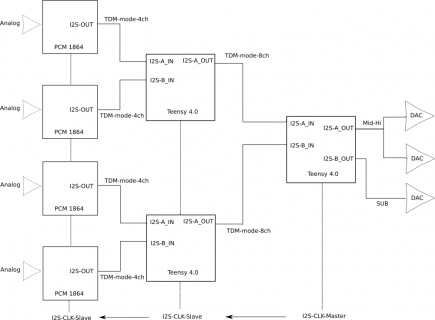Hi,
I am planning a new audio project using Teensy 4.0. This requires a significant number of ADC inputs coming from different ADCs. The intention is to have a central uC used to drive a UI via touchscreen and this device will also handle all outbound (i.e to DAC) DSP work. Postprocessing, limiting, EQ, crossover etc.
On the input side from the ADCs I need to offload the DSP work (EQ compression, reverb etc) to 2 Teensy4.0 devices, each of these will handle incoming I2S from at least 2 ADC ICs. So a total of 4 ADC ICs. The idea is to make the ADC chips modular to the system (pluggable). Here is the 1000 word picture, as a basic overview.

I see a significant issue based on the current Audio Library. This being that it is stated that only a single instance of the TDM object can be created for each Teensy? From what I understand each MMXRT1062 has 1 I2S module, but 2 TX and 2 RX interfaces, is it not possible to use both in TDM. If my memory serves me, the Kenetis chips can have independent data on each TX and RX pair, but they must share the same clocking scheme, i.e. master or slave. Therefore is this instantiation limitation just due to the current state of this library, or is there so more fundamental issue restricting this usage.
Any insights would be appreciated.
Aidan
I am planning a new audio project using Teensy 4.0. This requires a significant number of ADC inputs coming from different ADCs. The intention is to have a central uC used to drive a UI via touchscreen and this device will also handle all outbound (i.e to DAC) DSP work. Postprocessing, limiting, EQ, crossover etc.
On the input side from the ADCs I need to offload the DSP work (EQ compression, reverb etc) to 2 Teensy4.0 devices, each of these will handle incoming I2S from at least 2 ADC ICs. So a total of 4 ADC ICs. The idea is to make the ADC chips modular to the system (pluggable). Here is the 1000 word picture, as a basic overview.

I see a significant issue based on the current Audio Library. This being that it is stated that only a single instance of the TDM object can be created for each Teensy? From what I understand each MMXRT1062 has 1 I2S module, but 2 TX and 2 RX interfaces, is it not possible to use both in TDM. If my memory serves me, the Kenetis chips can have independent data on each TX and RX pair, but they must share the same clocking scheme, i.e. master or slave. Therefore is this instantiation limitation just due to the current state of this library, or is there so more fundamental issue restricting this usage.
Any insights would be appreciated.
Aidan

